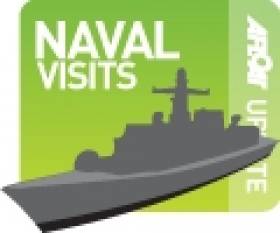Displaying items by tag: Canadian Navy
#navalvisits- A Royal Canadian Navy frigate HMCS Montréal made a morning arrival to Dublin Port yesterday having taken part in a major UK led exercise involving a large NATO fleet off Scotland last week, writes Jehan Ashmore.
The call of the 1994 'Halifax' class frigate follows Friday's visit to Ireland of Canada’s Minister of Environment and Climate Change, Catherine McKenna, to the Marine Institute headquarters in Oranmore, Co. Galway. Among the topics the minister discussed was climate change and collaborations under the Atlantic Ocean Research Alliance.
Only days later, due to the severity of Storm Ophelia, the Marine Institute decided to close the headquarters as the Red weather status storm swept across the country.
In advance of Ophelia and the Irish call, HMCS Montréal completed the exercise off Scotland and visited Glasgow from where also the Spanish frigate Álvaro de Bazán paid a call.
As Afloat previously reported, foreign naval calls to Irish ports can be very fluid including cancellation due to 'operational reasons' and this may apply to the frigate. An Italian Navy frigate however may instead be the next visitor on the Dublin Bay horizon, in the form of the FREMM class frigate ITS Luigi Rizzo.
Returning to the HMCS Montréal, the 134m Halifax class frigate role is for multi-role operations in that they are anti-submarine/aircraft and ship. Among the weapons systems are Sea-Sparrow SAM missiles. The 5,000 tonnes deep load frigate built by Canadian yard St. John Shipbuilding was commissioned into service in 1994 and has a crew complment of 225 that includes an air-wing.
Prior to the arrival of the Canadian visitor, the Irish Naval Service OPV90 class L.E. James Joyce was already docked in Dublin having sailed from Killybegs. During storm Ophelia,the OPV remained berthed at the Deepwater Quay along the south quays. This berth allocation for the Irish Navy is a first in terms of reporting on Afloat and previously other marine media.
It was within an hour's arrival of HMCS Montréal that the second of the OPV90 class sisters shifted berths in Dublin which involved L.E. James Joyce pass the visiting naval frigate. The move of berths led to the Naval Service vessel make a transit through the Tom Clarke toll-lift bridge to an upriver berth alongside Sir John Rogersons Quay.
#CanadianFrigate– HMCS Fredericton (FFH 337) a Canadian Navy Halifax-class frigate with a crew of 250 personnel of all ranks is on a visit to Cork City Quays having arrived in recent days, writes Jehan Ashmore.
The frigate berthed at J.J. Horgans Wharf has an extensive suite of anti-submarine warfare and anti-surface warfare weapons. In addition sensors to complement their substantial anti-air warfare defences.
HMCS Fredericton has been in service for 21 years with the Canadian Forces since her commissioning in 1994.
The 134m frigate represents the eighth ship in her class of 12 that are the backbone of the Canadian Navy. The class are based on the Canadian Patrol Frigate Project and they are capable of carrying a CH-124 Sea King helicopter.
In April she was understood to have taken part in NATO exercises held off Scotland.
The visitor is expected to depart Cork on Saturday and head for St. John's in Newfoundland.
Tripartite Naval Visitors for Dublin Port
Naval vessels from France, Canada and Belgium are due to make calls to Dublin Port over the weekend, writes Jehan Ashmore.
The first visitor to dock tomorrow will be the Latouche-Tréville (D646) a F70 type anti-submarine frigate of the French Marine Nationale. She is one of seven F70 ASM class anti-submarine frigates and is capable of carrying two 2 Lynx helicopters. In June 2010 the frigate visited London where the 1984 built 3,550 tonnes vessel moored alongside the WW II cruiser, HMS Belfast.
Also due to arrive tomorrow is the Canadian Navy's HMCS St. John's which too is to berth at Ocean Pier. HMCS St. John's (340) is the eleventh 'Halifax' class frigate, measuring some 4,770 tonnes. The multi-role patrol frigate was commissioned in 1996 in St. John's, Newfoundland and is designed to perform three distinct functions: anti-submarine warfare, anti-air warfare and anti-surface warfare.
On Sunday the third international naval visitor to Dublin Port will be the Belgium Navy's Léopold I (F930). This frigate is based in the Quartier Naval Base in Zeebrugge and in 1997 she was commissioned into service in a ceremony by Belgium's Queen Fabiola.
The 2,800 tonnes frigate is capable of taking two helicopters and the vessel can cruise at 21 knots using two diesel engines or is capable of reaching a top speed of 30 knots based from gas turbine power-plants. Léopold I has participated in NATO's Response Force (NRF). For a detailed visual discription of equipment click this link here

























































